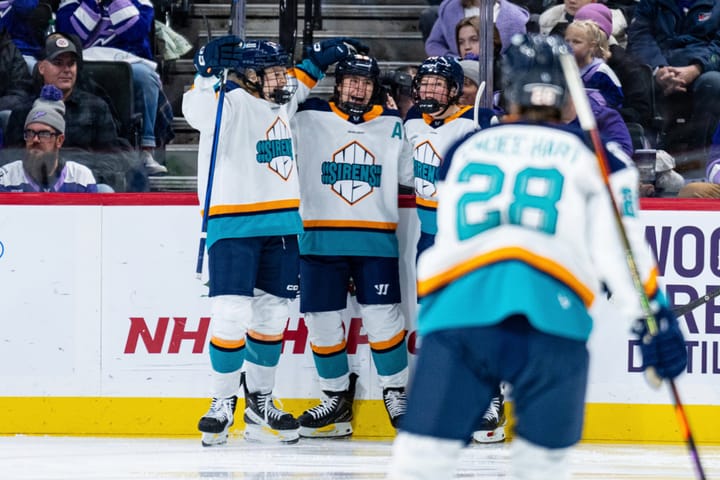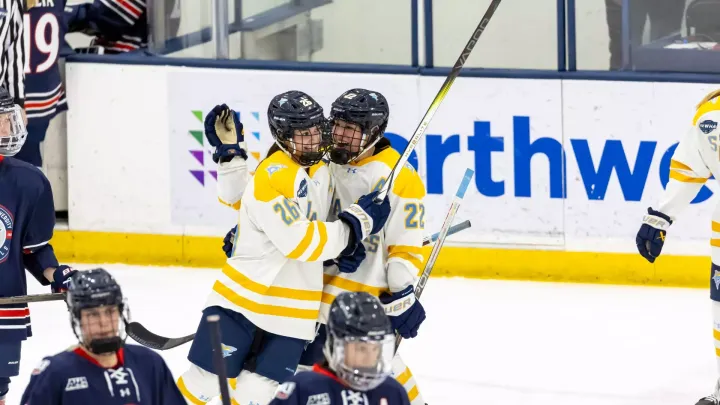The art of the faceoff: the game within the game
Some of the NWHL’s best centers talk about one of the most overlooked aspects of the game.
Early this season Erika Lawler enlisted the help of one of her Riveters teammates and asked them to repeatedly drop a puck in front of her in the locker room. To some, that might sound strange, but to Lawler it was just one more way to get an edge on the faceoff dot that night. After being away from the game for four years she has been keen to get her timing back. Lawler takes winning faceoffs in the NWHL very seriously. She’s not alone.
“Faceoffs are such an important element of the game,” Lawler explained to the Ice Garden. “I don’t think people pay enough attention to it. It can win and lose hockey games. For me they’re very important. Every single time I lose a draw I verbalize — I go, ‘Ahh!’ I get frustrated, I get mad about it. I’m very competitive about my faceoffs.”
The good news for Lawler is that she’s among the league’s best centers on the dot, although she admits to being “disgusted” with some of her faceoff performances this season. When things aren’t going well the veteran will seek counsel and talk shop with fellow Riveters’ centers Alexa Gruschow and Tatiana Rafter between periods. Similar scenes play out in the locker rooms of the NWHL’s other three teams; every center in the league wants to win the game within the game that takes place on nine red dots.
NWHL centers know their own faceoff numbers. When The Ice Garden talked to Alexa Gruschow about her winning percentage, she was quick to point out that she led the league in faceoff wins, but not not in winning percentage. She also offered insight into what is going through a center’s mind before the referee drops six ounces of frozen vulcanized rubber.
“We have a couple of set faceoff plays for every zone,” Gruschow explained. “Coming into the circle it’s the center’s job to call the play and make sure that everyone is set up correctly before you step into the dot ... When a game is coming down to the wire a faceoff can make it or break it, so it’s a huge aspect of the game that gets forgotten.”
“For centers you have the whole game and then you have your own little game against their centers,” Gruschow continued. “Lawler and I sit next to each other in our home locker room, so we do chat a good bit about faceoffs, especially if one of us tends to be losing a lot. We’ll figure out who’s winning and what’s working, and if we’re losing we talk about what we should do and what we think the other centers are doing.”
|For centers you have the whole game and then you have your own little game against their centers.” - Alexa Gruschow
NWHL centers are quick to learn each other’s tendencies. Somewhere in all of their brains there’s a playbook on the other centers in the league. Because there are only four teams the pages of that playbook get filled relatively quickly.Players are also quick to identify the best of the best and the centers who they hate to line up against.
“Babstock — she’s so good,” Gruschow laughed. “She’s so strong that she can just body you up, turn you around, and get the puck. Babstock is definitely a tough competitor.”
Gruschow isn’t the only elite center who considers Babstock a handful in the faceoff circle.
“I know Babs likes to poke it through you and step around you,” Pride captain Jillian Dempsey explained to The Ice Garden. “People get so low and intense on the draw — she’s quick enough to just step around them. I know that when I’m in my d-zone, when I’m against her, that she might try to do that. So I will adjust accordingly and do what I can to prevent that from happening.”
Babstock has lightning quick hands and is also incredibly strong. Those tools make her a formidable opponent for any center. The Canadian NWHL All-Star has a staggering 61.14 percent success rate on the dot, which is the best in the league among centers who have taken at least 150 faceoffs.
“I really like taking draws because it’s a battle and I love battling,” Kelly Babstock explained to The Ice Garden. “To be a good battler you have to use your body to win the draw. When I take a draw I’m telling myself, ‘I’m going to win this.’ Sometimes I don’t, and that’s fine. I just get excited for that next one, that next battle.”
Babstock’s technique is all about using her body for leverage and to push the other player away from the puck. It might sound simple, but it’s far from it. The centers of the Beauts, Riveters, and Pride know all about Babstock’s physicality on draws, but they can’t do much to stop her. She uses her strength in faceoffs perhaps more than any other NWHL center and clearly, as the numbers show, it’s working for her.
Lawler has a different approach. There’s no mistaking the profile of the 31-year-old Olympic silver medalist at the faceoff dot because she gets as close to the ice as she possibly can.
“I use my height to my advantage,” Lawler explained. “I get really low to the ice and drop my bottom hand on my stick quite a bit for leverage. I’m a player who learned how to manage my lack of size and lack of strength and I’m used to going against people who are a lot taller than me and more often than not stronger than I am. How do I compete against that? I need to bend my knees, get my inside edges into the ice, drop my bottom hand to get under the puck, and use my center of gravity to my advantage.”
Dempsey, the captain of the Boston Pride, focuses on what she’s trying to do rather than get wrapped up in what the player across from her wants to do. Hers is a cerebral approach; an adaptive approach. Dempsey reads the situation, calculates her strategy, communicates it to her teammates, and looks to execute. All of this happens in just a few seconds.
“When I go in to take a draw I like to scan and see who I’m up against as a unit,” Dempsey explained. “Who do they have on D? Who do they have on wings? Where are those people posted up? That way I can make last-minute adjustments and [tell them] to my wings or defensemen ... Minus trying to read the situation I just try to go low, keep my eye on the puck, and win.”
It’s a routine that Dempsey knows well, she and Gruschow are the only two centers in the league who average over 20 draws per game. She takes a lot of pride in her ability to win pucks on the dot and has for years. Dempsey re-dedicated herself to the skill while playing at Harvard University. During her time with the Crimson she noticed that when she was dominating on draws her team was winning more games.
When you win a faceoff it more often than not means winning puck possession. And having the puck is the first step to both scoring goals and keeping pucks out of your net. There are also crucial moments in games when your team simply needs to win a faceoff. In those moments nothing matters more than finding a way to win the puck cleanly or tying up the opposing center and allowing one of your teammates to swoop in and get to the puck. Just like goals, it doesn’t matter how you do it — all that matters is getting the win.
The methodology to winning faceoffs is part art form and part science. You need to be able to read body language, recognize tendencies, adapt accordingly, and react faster than your opponent. A lot happens in those few tense seconds before the fastest team sport in the world resumes play after a stoppage or at the top of a period.
Faceoffs are like a complex game of rock-paper-scissors that every hockey fan watches, but precious few take notice of. However, once you start watching the puck drop with the same intensity that the NWHL’s centers do, you’ll find that you can’t take your eyes off of it. You will notice centers pointing to their teammates like a field general, wingers jockeying for position at the edge of the dot, the different grips that centers have on their sticks, and the unflappable focus in their eyes. You’ll start to truly take notice of the game within the game.





Comments ()